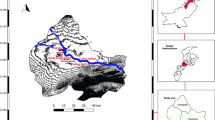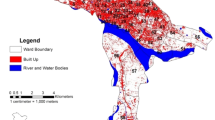Abstract
Global warming is increasing the variability of climate change and intensifying hydrologic cycle components including precipitation, infiltration, evapotranspiration, and runoff. These changes increase the chance of more severe and frequent natural conditions, and limit ecosystem function and human activities. Adaptation to climate change requires assessment of the potential disaster risk. The objectives of this study were to estimate the flood risk index (FRI) considering regional flood characteristics at the national level and to prioritize the factors affecting flood risk through principal component analysis. FRI was estimated based on the Delphi survey results from 50 water resources experts in South Korea. The potential risk analysis was conducted for 229 local governments in South Korea. The results showed that natural and social factors were more influential flood risk factors to South Korea than administrative and economic and facility factors. Specifically, natural, social, administrative and economic, and facility factors were, respectively, highest at Jindo-Gun in Jennam-Do, Gumi-Si in Kyongsanbuk-Do, Dong-Gu in Incheon-Si, and Suwon-Si, Kyonggi-Do. Overall, the highest FRI is shown in Anyang-Si, Kyongggi-Do. The spatial distribution of the FRI was high in the southeastern coastal region and basins of the two biggest rivers in South Korea, and normalized flood frequency followed spatial patterns similar to FRIs. This study provided information on the relative flood risk index among administrative units for investment prioritization in flood risk management. In this regard, the suggested FRI is expected to significantly contribute to methodical and economic improvements in budget allocations for flood risk management.



Similar content being viewed by others
References
Adger WN, Brooks N, Bentham G, Agnew M, Eriksen S (2004) New indicators of vulnerability and adaptive capacity. http://www.tyndall2.webapp3.uea.ac.uk/sites/default/files/it1_11.pdf. Accessed 30 April 2013
Brown B (1968) Delphi process: a methodology used for the elicitation of opinion of experts. The Rand Corporation, Santa Monica
Brown B, Halmer O (1964) Improving the reliability of estimates obtained from a consensus experts. The Rand Corporation, Santa Monica
Canter LW (1996) Environmental impact assessment, 2nd edn. McGraw Hill Book Company, New York
Choi SA, Yi CS, Shim MP, Kim HS (2006) Multi-dimensional expected flood damage assessment method (I): principle and procedure. J Korea Water Resour Assoc 39(1):1–9 (In Korean with English abstract)
Choi M, Jacobs JM, Cosh MH (2007) Scaled spatial variability of soil moisture fields. Geophys Res Lett 34:L01401. doi:10.1029/2006GL028247
Dalkey N, Helmer O (1963) An experimental application of the Delphi method to the use of experts. Manag Sci 9(3):458–467
Dawson RJ, Speight L, Hall JW, Djordjevic S, Savic D, Leandro J (2008) Attribution of flood risk in urban areas. J Hydroinform 10(4):275–288
Elmer F, Seifert I, Kreibich H, Thieken AH (2010) A Delphi method expert survey to derive standards for flood damage data collection. Risk Anal 30(1):107–124
Fedeski M, Gwilliam J (2007) Urban sustainability in the presence of flood and geological hazards: the development of a GIS-based vulnerability and risk assessment methodology. Landsc Urb Plan 83:50–61
Ferreira J, Vale C, Soares C, Salas F, Stacey P, Bricker S, Silva M, Marques J (2007) Monitoring of coastal and transitional waters under the E.U. Water Framework Directive. Environ Monit Assess 135:195–216
Green C (2004) The evaluation of vulnerability to flooding. Int J Disaster Prev Manag 13(4):323–329
Harvey H, Hall J, Peppé R (2012) Computational decision analysis for flood risk management in an uncertain future. J Hydroinform 14(3):537–561
Intergovernmental Panel on Climate Change (IPCC) (2007) Climate change 2007: impacts, adaptation and vulnerability. Working Group II contribution to the IPCC, 4th Assessment Report. Summary for Policymakers. http://www.meteotrentino.it/clima/pdf/rapporti_meteo/IPCC_Impacts_Adaptation_and_Vulnerability.pdf. Accessed 10 Nov 2013
Jonkman SN, Bockarjova M, Kok M, Bernardini P (2008) Integrated hydrodynamic and economic modeling of flood damage in the Netherlands. Ecol Econ 66:77–90
Kim YH (2001) The latest theories of environmental impact assessment. Sinkwang, Seoul (in Korean)
Koivumaki L, Alho P, Lotsari E, Kayhko J, Saari A, Hyyppa H (2010) Uncertainties in flood risk mapping: a case study on estimating building damages for a river flood in Finland. J Flood Risk Manang 3:166–183
Lamb R, Keef C, Tawn J, Laeger S, Meadowcroft I, Surendran S, Dunning P, Batstone C (2010) A new method to assess the risk of local and widespread flooding on rivers and coasts. J Flood Risk Manag 3:323–336
Lee SJ, Kim YO, Lee JH, Lee YY (2006) Improving potential flood damage for basin flood mitigation safety level. Proc Kor Water Resour Assoc 226–230 (In Korean with English abstract)
Lee CH, Lee SM, Shin SY, Yeo CG, Kim YJ (2007) Urban flood regional safety assessment model. Proc Kor Soc Haz Mitig 376–379 (In Korean with English abstract)
Morita M (2008) Flood risk analysis for determining optimal flood protection levels in urban river management. J Flood Risk Manag 1:142–149
Nardo M, Saisana M, Saltelli A, Tarantola S (2005) Tools for composite indicators building. European Commission-Joint Research Centre, Inspra. http://ipsc.jrc.ec.europa.eu/fileadmin/repository/eas/composite-indicators/Documents/EUR_21682_EN_Tools_for_Composite_Indicator_Building.pdf. Accessed 12 Oct 2013
Park T, Choi M, Yeo CG, Lee SO (2009) Analysis of regional flood damage characteristics using relationship between flood frequency and damages. J Kor Soc Hazard Mitig 9(5):87–92 (In Korean with English abstract)
Park T, Yeo CG, Choi M, Lee SO (2010) Flood damage index regarding regional flood damage characteristics. J Korean Soc Civil Eng 30(4B):361–366 (In Korean with English abstract)
Rao P, Murty KSR, Amminedu E (2005) Estimation of flood vulnerability index for delta areas through RS&GIS. Int Geosci Rem Sens Sym 5:3611–3614
Rygel L, O’Sullivan D, Yarnal B (2006) A method for constructing a social vulnerability index: an application to hurricane storm surges in a developed country. Mitig Adapt Strateg Glob Change 11:741–764
Taylor JG, Ryder SD (2003) Use of the Delphi method in resolving complex water resources issues. J Am Water Resour Assoc 39(1):183–189
Theobald DM, Goetz SJ, Norman JB, Jantz P (2009) Watersheds at risk to increased impervious surface cover in the conterminous United States. J Hydrol Eng 14(4):362–368
Trenberth KE, Jones PD, Ambenje P, Bojariu R, Easterling D, Klein Tank A, Parker D, Rahimzadeh F, Renwick JA, Rusticucci M, Soden B, Zhai P (2007) Observations: surface and atmospheric climate change. In: Solomon S, Qin D, Manning M, Chen Z, Marquis M, Averyt KB, Tignor M, Miller HL (eds) Climate Change 2007: the physical science basis. Contribution of Working Group I to the Fourth Assessment Report of the Intergovernmental Panel on Climate Change. Cambridge University Press, United Kingdom
Van Alphen J, Martini F, Loat R, Slomp R, Passchier R (2009) Flood risk mapping in Europe, experiences and best practices. J Flood Risk Manag 2:285–292
Vojinovic Z, Tutulic D (2009) On the use of 1D & coupled 1D–2D modeling approaches for assessment of flood damage in urban areas. Urb Water 6(3):183–199
Water Vision 2020 (2000) Integrative water resources management plan for a long period. Ministry of Land, Transport and Maritime Affairs in Korea (In Korean)
Zhang J, Okada N, Tatano H, Hayakawa S (2002) Risk assessment and zoning of flood damage caused by heavy rainfall in Yamaguchi prefecture, Japan. Flood Defence 2002. Science, New York, ISBN 7-03-008310-5
Acknowledgments
This research was supported by the Eco-Star Project (No.: EW32-07-10).
Author information
Authors and Affiliations
Corresponding author
Rights and permissions
About this article
Cite this article
Jung, Y., Shin, Y., Jang, C.H. et al. Estimation of flood risk index considering the regional flood characteristics: a case of South Korea. Paddy Water Environ 12 (Suppl 1), 41–49 (2014). https://doi.org/10.1007/s10333-014-0430-6
Received:
Revised:
Accepted:
Published:
Issue Date:
DOI: https://doi.org/10.1007/s10333-014-0430-6




